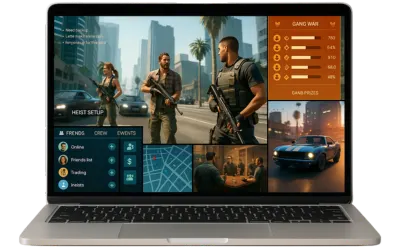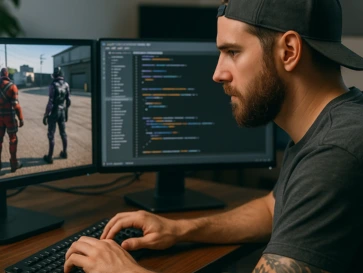Maximize revenue with a mix of in-game purchases, ads, and premium content. These strategies ensure profit while enhancing player engagement.
How to Develop a Game Like GTA
Grand Theft Auto (GTA) has redefined open-world gaming. From street-level chaos to massive multiplayer heists, its immersive gameplay and dynamic world-building have inspired countless developers to create similar experiences.
In this guide, we’ll walk you through how to develop a game like GTA, covering features, tech stack, development stages, and estimated costs ranging from $20,000 to $100,000. If you’re looking to enter the open-world game development space, this is your blueprint.



















Overview of the Grand Theft Auto (GTA) Game

Grand Theft Auto (GTA) is one of the most iconic and influential franchises in the gaming industry, known for its open-world design, mature storytelling, and gameplay freedom.
1. Open-World Gameplay: Players can freely roam cities, engage in missions, or explore side content.
2. Multiple Game Modes: Includes story mode and expansive online multiplayer (GTA Online).
3. Diverse Vehicles & Weapons: A Wide range of drivable cars, planes, bikes, and customizable weapons.
4. AI & Dynamic World: NPCs react realistically, with evolving environments and interactions.
Key Features of a Game Like GTA
Creating a GTA-style game involves integrating rich player interactions, vast open-world environments, real-time AI systems, and deep multiplayer dynamics. Such games also require seamless mission systems, diverse character customization, realistic physics, dynamic weather, and a strong narrative structure.

Player Features

Gameplay Mechanics

Multiplayer Integration

AI and NPC Behavior

Economy and Commerce

Immersion and Realism

Modularity and Customization
Cost to Develop a Game Like GTA
The cost can range from $20,000 to over $100,000 , depending on the game’s scale, features, and platform. High-quality graphics, complex AI, multiplayer support, and open-world design significantly impact the overall budget
Development Component
Estimated Cost Range ($)
Details
App Design
$5,000 - $15,000
UI/UX design, wireframes, user interface design for smooth and engaging experiences.
Frontend Development
$3,000 - $8,000
Frontend Development brings your app's interface to life, ensuring a seamless and engaging user experience across all devices.
Backend Development
$5,000 - $10,000
Backend Development powers your app’s core functionality, handling data, server logic, and seamless communication behind the scenes.
Testing & QA
$1,000 - $5,000/month
Ongoing updates, bug fixes, and adding new features after app launch.
Team Structure Required
Developing a game like GTA requires a multi-disciplinary team, often segmented as follows:

2D/3D Artists (environments, characters)

Game Developers (Unity/Unreal specialists)

Game Designers (storylines, mechanics)

Backend Developers (server and matchmaking)

UI/UX Designers

AI Engineers (NPC & police logic)

QA Testers
Technology Stack to Build a GTA-Style Game
At SDLC CORP, we deliver seamless gaming experience using Unity, Unreal Engine, C#, C++, and HTML5. Our tools include Photoshop, Blender, and Spine for superior graphics, while our secure backend uses Node.js, Socket.IO, Redis, and AWS.
We ensure data protection with SSL, PCI DSS compliance, and two-factor authentication.
Frontend
- React
- Vue.js
- React Native
Databases
- PostgreSQL
- MongoDB
- SQLite
Backend
- Node.js
- NET Core
- Python
Security
- iTech Labs
- eCOGRA
- GLI
Analytics
- Firebase
- Mixpanel
- Amplitude
Deployment
- Kubernetes
- Docker
- Azure
Testing & QA
- Selenium
- Appium
- Swagger
Game Engines
- Unity
- Unreal Engine
- Cocos2d-x
Game Development Process for GTA-Like Games
Uncover the behind-the-scenes blueprint of creating open-world action games. Here’s a step-by-step guide to building your own GTA-style masterpiece.

Massive Market Potential
Analyze gaming trends, competitors, and player preferences. Ensure your concept meets demand before development begins.

Game Design Document
Draft the blueprint of your game with clear mechanics, objectives, and features. This document guides every team involved.

World Building
Craft immersive worlds with rich lore and visual narratives. Storyboarding ensures smooth storytelling and mission flow.

Character Modeling
Design lifelike characters and dynamic environments in 3D. Focus on detail, realism, and performance optimization.

Mechanics Development
Code and refine game mechanics like combat, AI, and vehicle handling. Ensure smooth, engaging, and responsive gameplay.
Monetization Models We Support

- Enable secure trading of items using blockchain or a marketplace
- Allow players to earn or buy limited-edition assets
- Support peer-to-peer exchanges of in-game goods
- Use scarcity to drive demand (limited mints or drops)
- Ensure compatibility across platforms or future games

- Introduce new maps, missions, or story arcs
- Release expansion packs post-launch to extend game life
- Bundle DLCs with premium editions or season passes
- Use story-driven content to deepen immersion
- Offer early access or bonuses for pre-orders

- Place ads subtly on billboards, radio, or in-game menus
- Use rewarded ads (e.g., watch to get currency or power-ups)
- Ensure ad frequency doesn’t interrupt gameplay flow
- Partner with relevant brands to keep ads immersive
- Track ad impressions and clicks for optimized revenue

- Offer tiered reward systems with free and premium tracks
- Unlock exclusive gear, missions, or vehicles for premium users
- Time limit each season to drive recurring engagement
- Allow players to level up the pass through gameplay
- Include prestige rewards or collectibles to increase value

Built-in affiliate system with customizable referral links
Set commission models: CPA, RevShare, or Hybrid
Track performance via real-time analytics dashboard
Integrate third-party platforms (Tapfiliate, Post Affiliate Pro)
Manage affiliate payouts, bonuses, and ranks easily

- Collaborate with real-world brands for in-game billboards
- Introduce branded vehicles, outfits, or mission events
- Host virtual concerts or events sponsored by partners
- Integrate product placement within the storyline organically
- Track impressions and engagement for brand ROI
Learn How to Build a GTA-Style Game from Scratch Today!

Our Blogs on Games Like GTA
Explore our insightful blogs on gaming apps, offering valuable tips, trends, and strategies to help you grow and optimize your online business. Stay updated with the latest developments and best practices in the online gaming.
Why Choose SDLC Corp To Develop a Game Like GTA
SDLC Corp specializes in developing high-performance, scalable apps with cutting-edge technologies. Our team ensures seamless user experiences, real-time data integration. With expertise in mobile app game development, we deliver customized solutions tailored to your business needs. Our post-launch support guarantees continuous performance and updates for optimal user satisfaction.
Expert Team
Skilled in React Native, Node.js, and secure payment integration for robust app development.
Customized Solutions
Tailored to your unique business requirements, ensuring a competitive edge in the market.
Post-Launch Support
Ongoing maintenance and feature updates to ensure your app stays ahead of the competition.
Our Clients’ Experience With Us
From startups to global enterprises, we’ve helped businesses unlock real value through AI and digital innovation. Here’s what our clients have to say about partnering with us their wins, our collaborations, and the impact we’ve made together.

Stuart John
CEO at benith horizon corp
I had the pleasure of working with SDLC Corp for my company’s web app development needs. Their app development services were excellent, and they went above and beyond in creating a mobile app with excellent UX and UI design. I highly recommend them for anyone looking to develop a mobile app.
Overall Satisfaction

Kofi Mensah
Sr. Manager emberfield associates
SDLC Corp was the perfect choice for our company’s mobile application development needs. They were able to develop both the iOS and Android versions of our app with a seamless user experience. Their team was responsive and professional throughout the project.
Overall Satisfaction

Hamza Al Lawati
CEO at Wadiaa
I was impressed with the project development solution provided by SDLC Corp for my mobile app. Their cross-platform apps are available on both the iOS (apple app store) and Android app stores, and I highly recommend them as
a mobile app development company.
Overall Satisfaction
Contact Us
Share a few details about your project, and we’ll get back to you soon.
Let's Talk About Your Project
- Free Consultation
- 24/7 Experts Support
- On-Time Delivery
- sales@sdlccorp.com
- +1(510-630-6507)


